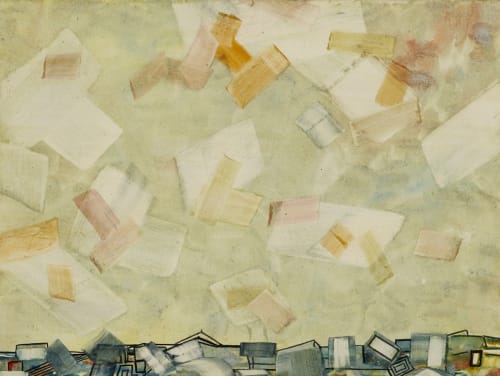The prolific Hampstead painter Lancelot Ribeiro was one of the most original of the Indian artists who settled in Britain in the post-war period. An exhibition of his life and work is on display at Burgh House as part of the year-long 'Retracing Ribeiro' programme, supported by the Heritage Lottery Fund and being celebrated as part of the 2017 UK-India Year of Culture, in partnership with The British Museum, V&A, Central Saint Martins and Camden Archives. The exhibition will explore Ribeiro's legacy through an extensive programme of exhibitions, film and talks.
After settling in Britain after the Second World War, Indian born Lancelot Ribeiro produced a vast body of figurative and abstract works. Although Ribeiro's fame never rose to that of his contemporaries such as Anish Kapoor or FN Souza during his lifetime, his work is increasingly popular amongst collectors, dealers and critics. Over the 50 years of his career, Ribeiro worked with traditional oil painting and acrylic, producing explosive surreal works, wood sculptures and ceramics. He is currently seen as one of the most innovative Indian artists of the last half-century living in Britain.
After moving to Chalk Farm in 1950 to study accountancy, Ribeiro initially lived with his half-brother, the painter Francis Newton Souza, where Ribeiro's path was soon diverted to that of art. After attending life drawing classes at Central Saint Martin's he started painting professionally from 1960 onwards. His show at the Bombay Art Society Salon was completely sold out and attracted rave reviews. His artistic career was underlined by his fascination with poetry and artistic innovation, often leading him to experiment with a variety of styles, techniques, media and pigments. Known for his fast-paced working methods, Ribeiro grew increasing dissatisfied with the drying times and lack of colour brilliance in traditional oil paints and started to experiment with acrylic materials. He worked closely with large paint manufacturers such as ICI, Courtaulds and Geigy to improve the material's quality. His polyvinyl acetate (PVA) acrylic has been called 'one of the most significant advances in artistic technique of the twentieth century'.
 Lancelot Ribeiro, Grey Landscape, 1985
Lancelot Ribeiro, Grey Landscape, 1985
The Camden Collection holds two works by Ribeiro, both of which will be on display at Holborn Library 10 April - 27 May 2017 as part of the 'Retracing Ribeiro' programme. Landscape with red sky and Grey Landscape, both from 1985, show the depth of color and subtle layering techniques Ribeiro was known for, with bright reds and soft yellows that recall the skies and sands of his homeland India. Part of a new abstract phase the artist began in the eighties, these compositional multi-dimensional landscapes were produced on laminated card and combined watercolours, varnishes and inks to produce dynamic townscapes, reduced to the base of the image, dominated by a seemingly active sky. They explore issues of identity, cultural marginalisation and colonial history, while at the same time expressing deep feelings of poetic longing.
The two works in the Camden Collection reflect the artist's engagement with both India and the UK. Inspired by the walks Ribeiro took with his daughter Marsha on Hampstead Heath, they reflect the melancholy and desires of a man on the other side of history, looking out over a land that reflected both colonial oppression and the future of not only himself but his family. His paintings recall a changing world in which borders are redefined and cultural migration and collaboration is ever still a pressing issue. This limited series is currently the focus of the 'Retracing Ribeiro' exhibition, supported by the Heritage Lottery Fund, at Burgh House & the Hampstead Museum.
Burgh House exhibition, 25 October 2016 - 19 March 2017
Camden Archives exhibition, 10 April - 27 May 2017. Talk by David Buckman, Ribeiro's biographer, 25 April 2017.
For the full programme, visit www.lanceribeiro.co.uk. For more information on the UK-India Year of Culture please visit http://uk-india.britishcouncil.in/

The Camden Art Collection comprises a rich variety of works dating from the late 1950s to today, by artists who have had a strong connection to the borough, including Sandra Blow, Jean Cooke, John Bratby, Maggie Hambling, Derek Jarman, Prunella Clough, Terry Frost, Adrian Heath, Wilhemina Barns-Graham and limited edition works on paper by David Hockney and Patrick Caulfield. For more information visit our online archive.
Header image: Lancelot Ribeiro, Landscape with a red sky, (1985), Courtesy of Camden Collection

